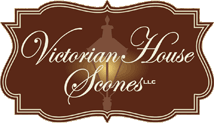In checking voice mail messages one evening, I had a message from someone who was clearly upset. She left a message asking about the baking temperatures listed in our directions. She thought the temperature listed was too hot.
I called and asked her what had happened. She’d made the dough and baked all the scones. The bottoms of all her scones were either scorched or burned. I told her that the baking temperatures were correct as listed, but did she have time for me to ask her a few questions. I was reasonably sure I knew what had happened, but you know what they say about assumptions.
My questions were:
1. Did the parchment paper turn tan? (YES)
2. Did you make up the dough, cut the scones and put them on the cookie sheet to bake, and then begin pre-heating the oven? (YES)
3. How cold was the butter when you started making the dough? (refrigerator temperature)
The primary issue here is the answer to question 1. The fact that the parchment paper turned tan is a good indicator that the oven was running hot. I don’t know why many ovens, mine included, age this way, but they do. As they age, they may run true to temperature in the mid-temperature ranges, but as you get higher than 400 degrees, will run too hot. The easy solution for this is to purchase an oven thermometer and do some simple checking of your oven settings. For my oven, I set the temperature back 20 degrees to 405, and now my scones bake correctly.
There were other factors, however, which contributed to the problems with her scones. Letting her cut scones sit on the parchment paper while the oven preheated gave the butter time to warm and seep into the parchment paper. Likely there was a nice buttery spot under each scone before those scones went into the oven. As soon as the heat hit that spot, the butter scorched, causing the bottoms to burn. (And by the way, she did NOTHING wrong by starting with refrigerator temperature butter. While even colder butter is better, the real problem was the time spent waiting to for the oven to preheat.)
If you find out that you forgot to start the oven preheating, just pop the scones into the freezer while the oven heats, and then replace the parchment paper with a fresh sheet before baking.
Here are a few “ounce of prevention” baking tips:
1. If you are baking something for the first time, bake as few as possible for the first batch, and set the timer for the minimum time called for by the recipe. This lets you make sure both the temperature and time settings are accurate.
2. If you are baking one cookie sheet of scones, cookies, or biscuits–set the rack to the central position in the oven.
3. If despite your best efforts they still scorch slightly, double up your cookie sheet. Just the little bit of extra insulation on the bottom does wonders!
As for my unhappy caller–it is always disappointing to take out your finished creation and discover it not what you anticipated. Creative thinker that this woman is, she sliced off the bottoms of the scones, served them anyway, and explained that they were lower in calories without the bottom crust!! And since the first words out of my mouth had been “we need to replace that bag for you”, I’m now looking forward to hearing about her next batch of scones!

 Cart
Cart
I have a new as range & it burns or scorches everything I bake & the top cooks too quickly. My gas barbecue did too. I turned down the gas supply & it is good. Can I do the same with my gas stove.
I don’t know what to say about turning down the gas supply to your new range. Have you put a thermometer into the oven to see how hot it IS running, and then talk to your installer about properly calibrating the oven? I would also check with the gas company about actually turning down the gas supply to the oven, and ask them to measure the amount of gas reaching the appliance. Maybe the flow to your home is higher than they think??
In the meanwhile, I’d turn down the oven temperature, and consider doubling up the cookie sheet to prevent scorching. Good luck! I hope this helps!